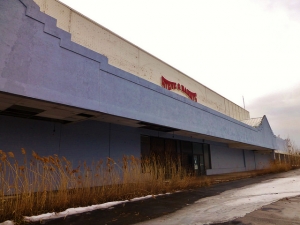
You’ve probably seen one – an abandoned and ugly vacant big box store. Usually, there is graffiti covering broken glass doors and a huge, empty parking lot. These buildings have been designated “ghostboxes.”

Photo by Nicholas Eckhart is licensed under CC BY 2.0
When big box stores and super centers hit hard times, many were simply were shuttered. The result was lots of large empty buildings. In 2013, 12 different retailers closed more than 2,500 stores across the country. More have closed in the ensuing years. Considering that most of these buildings averaged between 60,000 square feet for smaller stores and 250,000 square feet for supercenters, that resulted in lots of empty space in cities throughout the U.S.
These once-popular sprawling buildings with their expansive parking required all kinds of infrastructure upgrades. For instance, in most cities, when big box stores were built, accommodations were made to handle increased traffic. Sometimes surrounding roads were widened, additional stop lights may have been installed and highway entrance and exit ramps were likely added. When the stores began to close, the infrastructure investment for many cities was in jeopardy of being lost forever.
Communities around the country, however, worked to make sure something positive happened. Instead of letting ghostboxes become eyesores, visionary public officials saw the potential for reuse, restoration and economic development.
In McAllen, Texas, one empty big box store was renovated and turned into the largest single-story public library in the country. The 123,000 square foot building’s vast space allowed architects to strategically divide the building into various sections that included public meeting spaces, computer labs, a book store and a cafe. Architects managed to create a sense of intimacy in the library, despite the store’s cavernous interior. The city spent $14.2 million on renovations but that was significantly less than what a much-needed new library would have cost.
Another ghostbox in Charlotte, N.C., was renovated to become the home of a local charter school. The neighborhood in Charlotte was dealing with inadequate educational facilities for years, and renovating the abandoned building was just what was needed. The empty big box store had limited outer wall space for classroom windows, so the architects installed skylights for natural light and the school now serves over 500 students.
An abandoned grocery store in Latham, N.Y., became a nondenominational church that now boasts a massive 1,500-seat sanctuary, 15 classrooms, two cafes, multiple meeting rooms, offices and a youth center. The church saw the benefit of prime real estate located at the intersection of two nearby highways.
Other ghostbox renovations have resulted in fitness/wellness centers, museums, office and retail spaces, apartment complexes and even an indoor go-kart raceway. Public officials and innovative economic development teams have proven that life can occasionally be made even better when change occurs. Congrats to visionary community leaders.
SPI’s government market research can identify redevelopment opportunities in any state. Contact them today.
